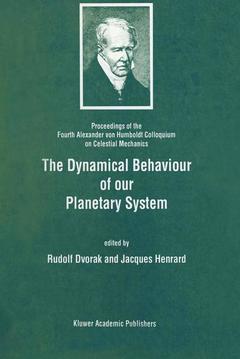Description
The Dynamical Behaviour of our Planetary System, Softcover reprint of the original 1st ed. 1997
Proceedings of the Fourth Alexander von Humboldt Colloquium on Celestial Mechanics
Coordinators: Dvorak Rudolf, Henrard Jacques
Language: English
Subject for The Dynamical Behaviour of our Planetary System:
Keywords
Celestial mechanics; Planet; Planetary system; Solar System; solar
Publication date: 10-2012
428 p. · 16x24 cm · Paperback
428 p. · 16x24 cm · Paperback
Description
/li>Contents
/li>Comment
/li>
It is now a well established tradition that every four years, at the end of winter, a group of "celestial mechanicians" from all over the world gather at the "Alpen gasthof Peter Rosegger" in the Styrian Alps (Ramsau, Austria). This time the colloquium was held from March 17 to March 23, 1996 and was devoted to the Dynamical Behaviour of our Planetary System. The papers covered a large range of questions of current interest: theoretical questions (re- nances, universal properties, non integrability, transport, ... ) and questions about numerical tools ( symplectic maps, indicators of chaos, ... ) were particularly well represented; the never ending problem of the sculpting of the asteroid belt was also qui te popular. You will find in the following pages a pot-pourri of what we listen to; you will miss of course the diversity of accents with which the tunes were delivered: from China, from Japan, from Brazil, from the United-States of America and from all over Europe, East and West. Let us not forget that the comet 199682 (Hyakutake) came to visit us; many an evening was spent on the deck of the Alpengasthof contemplating this celestial visitor who liked to play hide-and-seek behind the spruce trees.
Scattering by Resonances.- Non-Integrability in Hamiltonian Mechanics.- Regular and Irregular Periodic Orbits.- Universal Properties of Escape in Dynamical Systems.- Mapping and Dynamical Systems.- A New Fast Fourier Method for Evaluating Fourier Spectra at Arbitrary Frequencies.- On the Use of Analytical Theories in the Calculation of Precession-Nutation.- The Nekhoroshev Theorem and the Asteroid Belt Dynamical System.- Frequency Modified Fourier Transform and its Application to Asteroids.- The Trojan Problem.- Dynamical Transport to Planet-Crossing Orbits.- Review of the Dynamics in the Kirkwood Gaps.- Open Problems on the Eve of the Next Millennium.- Limit of Comprehension, Reference Frames Reference Frames and General Relativity.- Stable Chaos: A First Model.- Transport in Perturbed Integrable Hamiltonian Systems and the Fractality of Phase Space.- Equilibria Bifurcations of Satellite Orbits.- Fast Lyapunov Indicators. Comparison with Other Chaos Indicators. Application to Two and Four Dimensional Maps.- Asteroid Motion near the 2:1 Resonance: A Symplectic Mapping Approach.- Symplectic Integrators for Hill’s Lunar Problem.- Rotation Number and Global Stability of Symplectic Integrator.- On a Global Expansion of the Planar Disturbing Function.- Links betwen Time Scales Using Barycentric Relativistic Ephemerides.- Orbital Stability of Planetary Quasi-Satellites.- Alternative Derivations of Perturbations with Use of a Mixed Reference-Plane System: Application to the Motion of the Orbit Plane of Hyperion.- Astrodynamic Study of the Earth Rotation.- Orbital Evolution of Asteroids in the Hecuba Gap.- A Study of the Local Lyapunov Numbers for Orbits in the Outer Solar System.- On the Influence of Supernova Shockfronts on the Stability of the Solar System.- HenriPoincaré: A Decisive Contribution to Special Relativity.- Periodic Orbits in the Sitnikov Problem.
The papers in this volume cover a large range of questions concerning the dynamics of objects of the Solar System, from theoretical Hamiltonian mechanics to the study of the dynamical behaviour of specific objects, with a strong emphasis on the detection, causes and effects of chaotic behaviour. Several papers describe the very latest contributions in two very lively and recent topics which are considered as major breakthrough in numerical dynamics: symplectic methods of numerical integration of Hamiltonian systems, and methods for spectral analysis of numerically computed orbits leading to refined tools for the detection and evaluation of chaos. The dynamics of the asteroid belt and other small objects, a fast-moving topic with important implications for the origin and evolution of the So
© 2024 LAVOISIER S.A.S.




